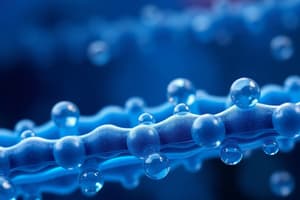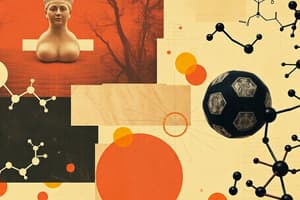Podcast
Questions and Answers
What characteristic makes steroids unique from one another?
What characteristic makes steroids unique from one another?
- Their overall polarity
- The groups attached to their fused carbon rings (correct)
- The length of their fatty acid chains
- The number of carbon rings they contain
Which of the following is a consequence of high cholesterol levels?
Which of the following is a consequence of high cholesterol levels?
- Increased oxygen flow to the arteries
- Formation of plaque in arteries (correct)
- The development of sex traits
- Enhanced growth rate
What role do anabolic steroids play in the body?
What role do anabolic steroids play in the body?
- Lower blood pressure
- Mimic testosterone's effects (correct)
- Increase production of cholesterol
- Inhibit gamete production
What is a primary function of cutin, a type of wax found on plants?
What is a primary function of cutin, a type of wax found on plants?
Which statement accurately describes waxes?
Which statement accurately describes waxes?
Which types of molecules do lipids primarily consist of?
Which types of molecules do lipids primarily consist of?
What is the primary function of lipids in living organisms?
What is the primary function of lipids in living organisms?
What process leads to the formation of a triglyceride?
What process leads to the formation of a triglyceride?
Which type of fat is characterized by having only single bonds and being solid at room temperature?
Which type of fat is characterized by having only single bonds and being solid at room temperature?
What happens to excess carbohydrates in the body?
What happens to excess carbohydrates in the body?
What characterizes the hydrocarbon chains in fatty acids?
What characterizes the hydrocarbon chains in fatty acids?
Why are lipids not soluble in water?
Why are lipids not soluble in water?
What effect does a longer hydrocarbon chain have on solubility?
What effect does a longer hydrocarbon chain have on solubility?
What property of phospholipids allows them to form a bilayer in cell membranes?
What property of phospholipids allows them to form a bilayer in cell membranes?
Which type of fat contains trans double bonds and is harder for the body to break down?
Which type of fat contains trans double bonds and is harder for the body to break down?
Which of the following statements about saturated fats is accurate?
Which of the following statements about saturated fats is accurate?
What is the primary composition of a phospholipid?
What is the primary composition of a phospholipid?
What makes unsaturated fats different from saturated fats?
What makes unsaturated fats different from saturated fats?
What structural arrangement do phospholipids adopt when forming a micelle?
What structural arrangement do phospholipids adopt when forming a micelle?
How do water and polar molecules interact with the phospholipid bilayer?
How do water and polar molecules interact with the phospholipid bilayer?
Flashcards are hidden until you start studying
Study Notes
Overview of Lipids
- Lipids are essential biomolecules categorized into four families: fats, phospholipids, steroids, and waxes.
- Primary functions include energy storage and membrane construction in organisms.
Polarity of Lipids
- Composed of hydrophobic molecules primarily containing carbon, hydrogen, and oxygen.
- Exhibit fewer polar O-H bonds and a higher number of non-polar C-H bonds, leading to low solubility in water.
- Soluble in non-polar solvents and can contain long hydrocarbon chains or compact ring structures.
Energy Storage
- Lipids serve as the dominant energy-storing molecules in living organisms.
- Contain approximately 38 kJ of chemical energy per gram, exceeding the energy stored in carbohydrates or proteins (around 17 kJ).
Conversion of Excess Carbohydrates
- Excess carbohydrates in the body are converted into fat for storage.
- Fat molecules accumulate as droplets in adipose tissue, providing insulation and a protective layer under the skin.
Triglycerides (Triacylglycerols)
- Most prevalent type of fat, comprising glycerol (a 3-carbon alcohol) and three fatty acids.
- Fatty acids contain long hydrocarbon chains (16-18 carbons long) with a carboxyl group at one end.
Esterification Process
- Formation of triglycerides occurs through esterification, a condensation reaction creating ester bonds between glycerol and fatty acids.
- Water is produced by removing a hydrogen from glycerol and a hydroxide from the fatty acid during the process.
Fat Types
- Saturated Fat: Solid at room temperature, consists of single bonds, and causes kinks in the chain.
- Unsaturated Fat: Contains at least one double bond, remains liquid at room temperature, and has fewer hydrogens attached.
Health Implications of Saturated Fats
- Longer hydrocarbon chains increase London dispersion forces, resulting in decreased solubility and increased difficulty in breakdown.
- Consumption of saturated fats is linked to increased risks of heart disease.
Trans-Fat
- Man-made unsaturated fat characterized by trans-based double bonds, resulting in straight fatty acid chains and reduced solubility.
- Our bodies struggle to break down these bonds, posing health risks.
Phospholipids
- Phospholipids form the primary component of cell membranes.
- Composed of glycerol, two non-polar fatty acids, and one phosphate group. The phosphate is charged and generally connects to a polar molecule.
Phospholipid Structure
- Amphipathic nature: phosphate group is polar (hydrophilic) while fatty chains are non-polar (hydrophobic).
- Arranges in a micelle formation with tails facing inward and heads facing outward, protecting the tails from water.
Phospholipid Bilayer
- Cell membranes consist of a phospholipid bilayer with fatty chains inside and phosphate heads outside, controlling substance entry/exit.
- Water and polar molecules typically require assistance to penetrate the layer.
Steroids
- Steroids possess a structure of four fused carbon rings, with unique groups attached defining each steroid.
- Common steroids include sterols, generally hydrophobic with one hydroxyl group (slightly polar). Examples: testosterone and cholesterol.
Sterols and Health Effects
- Cholesterol: High levels can cause atherosclerosis, obstructing arteries and increasing heart attack risks.
- Testosterone: Regulates sex traits and gamete development; anabolic steroids can raise blood pressure and impair growth.
Waxes
- Waxes comprise long fatty acid chains attached to alcohols or carbon rings, classified as hydrophobic and non-polar soft solids.
- Cutin, a wax found on plants, offers waterproofing, aiding in water conservation and infection protection.
Studying That Suits You
Use AI to generate personalized quizzes and flashcards to suit your learning preferences.




